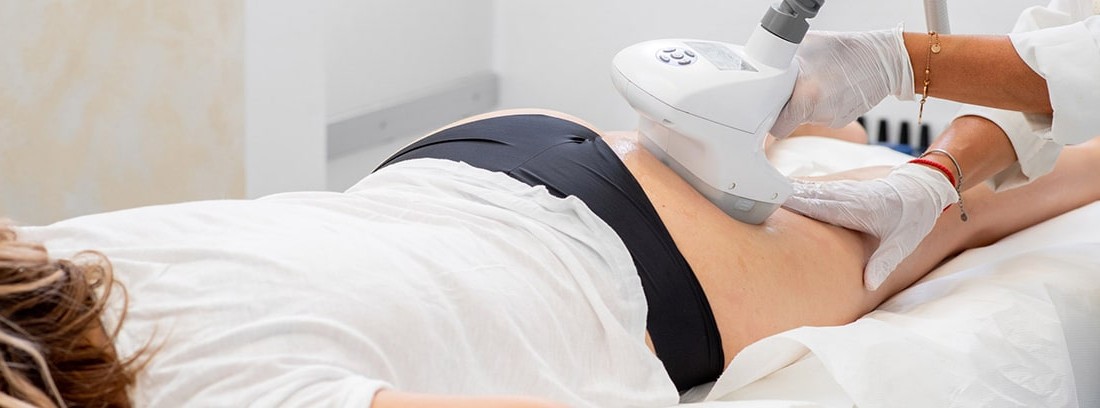What is lipedema?

The fat deposits are symmetrical at both extremities and range from the hips, thighs and legs stopping at the ankles, without affecting the foot. In the initial stages, the increase in fat deposits in the buttocks and hips can give an image called “sign of saddlebags or holsters” or “in riding pants”. When fatty deposits affect the entire limb, the image of “baggy pants” appears, with great disproportion between the upper and lower half of the body. In more advanced stages it can also cover the upper limbs.
Phases of lipedema
Taking into account the extension, there are five phases:
- Phase i: Fat increases in thighs and buttocks.
- Phase ii: the lipedema extends to the knees, forming pads on the inside of them.
- Phase III: lipedema extends from the hips to the ankles.
- Phase iv: involvement of upper limbs and lower limbs.
- Phase V: lipolymphedema. There is also a lymphedema problem added to the picture because the lymphatic system is affected.
Signs and characteristics
The diagnosis of lipedema is relatively easy and fundamentally clinical. The following characteristics are given:
- It mainly affects
- There is almost always a family predisposition.
- The hormonal component It's very important; It begins at puberty and often worsens coinciding with pregnancy, menopause, taking contraceptives ...
- Skin stretches Due to the fat content, it loses elasticity and is fine and smooth.
- Hypersensitivity and pain to light contact, palpation, pressure and cold.
- Frequent bruising, because small blood vessels are fragile and break with minimal blows or spontaneously.
- Spider veins (telangiectasias) especially on the lateral aspect of the thigh.
- Sensation of swelling and swelling that does not improve with a night's rest.
- Digestive problems and alterations of the.
- Dificulty to walk for the pain and joint dysfunction that occurs with immobility.
- Negative Stemmer sign, with a pinch the skin is separated from the fat (in lymphedema it cannot be).
- Non-pitting edema, When squeezing and removing the finger on the leg, there is no trace in the tissue as it would appear in a swollen leg or in lymphedema.
It is frequent psychological impairment and stress, associated with self-esteem problems, altered body image, size disparity between the upper and lower half of the body and the consequent difficulty in finding clothes to be comfortable with, limitation of social and sexual life, feelings of despair and limitation of the quality of life and professional development among others.
Differential diagnosis with other diseases
It may be necessary to rule out other diseases such as obesity, lymphedema and PEFE (Panniculopathy Edemato Fibro Sclerosa) among the most frequent. Imaging tests are not necessary, but they can help with differential diagnosis or follow-up.
Treatment for lipedema
Early diagnosis and treatment are essential, since the gradual increase in fat deposition causes loss of mobility and other associated problems such as osteoarthritis and. Thus, treatment focuses on improve symptoms and prevent progression and the disability that the disease can generate.
Patients with lipedema who remain normal weight and regularly engage in physical activity have fewer symptoms, better functional capacity, and fewer complications than those who do not.
Suitable weight
It is important to clarify that an adequate weight, a strict diet and intense exercise do not reduce the volume of lipedema. Lipedema can be observed in patients with normal weight, low weight, even in anorexic patients. But being overweight / obese impairs mobility, favors osteoarticular complications and affects the quality of life and self-esteem of patients. That is why it is essential to carry out anthropometric measures (weight, height, BMI, waist / hip circumference index) and bioimpedance techniques for the adequate # _edn1stico diagnosis of overweight / obesity and to program actions to reach a normal weight.
Physical activity and avoiding sedentary lifestyle
Lack of mobility is common in patients with lipedema due to limitation due to increased volume of the # _edn1 members, pain, and joint restriction, especially in the hips and knees, especially in older patients. Furthermore, the association of aggravating factors such as obesity, and psychological impairment leads these patients to limit their social life.
Limb decongestion
It should be studied if there is edema of systemic origin (renal, cardiac, hepatic, due to hypoproteinemia, drug) or local (deep vein thrombosis, lymphatic) to treat it specifically.
It is necessary to point out that the fatty tissue is not reduced with compression, but , lymphatic drainage, and drugs specific for pain with neuropathic characteristics, have been shown to be useful in the pain reduction characteristic of lipedema, it gives support to the tissues and comfort to the person. It also helps to reshape the limbs if there is associated edema.
Surgical treatment
Eliminate fat and reduce volume by liposuction. In the long term, liposuction brings remarkable and long-lasting benefits, in terms of subjective symptoms.
Surgical treatment in lipedema is indicated in any case, especially if the patient does not improve with conservative treatment. It must be preceded by six to eight months of conservative treatment, weight control, and emotional balance. Liposuction in lipedema requires a specific technique and
- It is characterized by a progressive, exaggerated and uneven accumulation of fat in the subcutaneous adipose tissue of the lower limbs.
- It mainly affects women. There is usually a family predisposition and the hormonal component is very important.
- Treatment focuses on improving symptoms and preventing the progression and disability that the disease can cause.
Family Medicine Specialist
(Updated at Apr 13 / 2024)